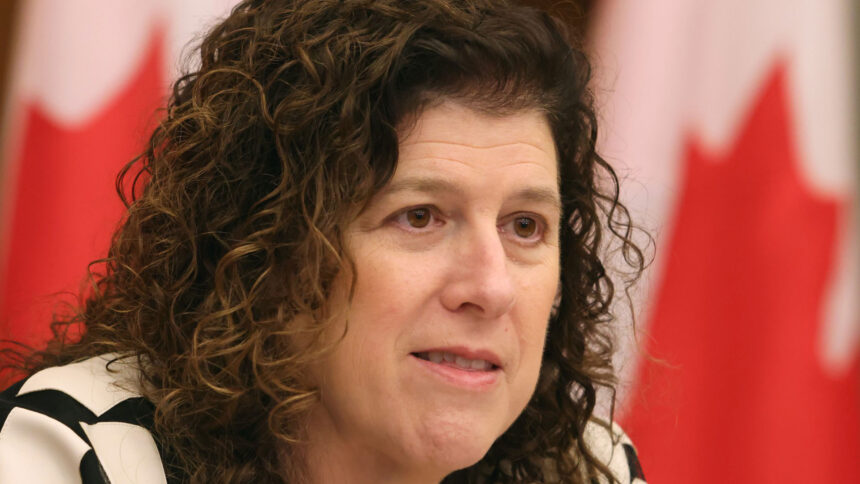A new report from the federal auditor general says that Indigenous Services Canada (ISC) failed to implement more than half of the previous recommendations to improve programs and services made over the last decade. This, says Karen Hogan, despite a staggering 84 per cent increase in funding, from about $13 billion in 2019–20 to almost $24 billion in 2023–24. Hogan’s report, released on Tuesday, is a follow-up audit that reviewed 34 recommendations from six previous reports issued between 2015 and 2022. According to the report, ISC made “unsatisfactory progress” and only implemented 18 out of the 34 recommendations in those six reports. The audit’s findings are especially alarming in two areas: access to safe drinking water and emergency management services. Both have been under federal scrutiny for more than two decades. Yet, not only did ISC fall short of expectations, but in some cases, it has actually lost ground. A broken promise on clean water Boil water advisories continue despite promises Photo: APTN News In its 2015 federal election promise, the Liberals promised to end all long-term drinking water advisories in First Nations communities by March 2021. As of April 1, 2025—when the auditor general’s review was finalized—35 long-term advisories were still in place. Nine of them had been in effect for more than a decade. That’s one quarter of all current advisories. Most are in Ontario. “We are concerned that many people living in First Nations communities continue to not have access to safe drinking water. We found that about one quarter of these advisories (9 of 35) had been in effect for a decade or longer,” says the report. Since the audit was completed, the number has gone up. According to ISC’s website, there are now 38 long-term advisories—three more than when the report closed. The problem isn’t new. The auditor general first investigated drinking water in First Nations communities back in 2005 and has returned to the issue three times since. This most recent report found that ISC had not made satisfactory progress on any of the five recommendations related to water safety. A key recommendation was that ISC build a regulatory framework that spells out standards, responsibilities, and, importantly, funding to ensure clean water systems are sustainable. A legislative attempt to address this, Bill C-61 (the proposed First Nations Clean Water Act), was introduced in late 2023 but died on the order paper when Parliament was prorogued in January 2025. That means First Nations communities are still without legally enforceable drinking water protections—unlike municipalities and provinces across the country. In the meantime, families in 38 Communities must continue to boil, bottle, or treat their own water. Assembly of First Nations National Chief Cindy Woodhouse Nepinak asked the government months ago to re-introducer the Clean Water Act as soon as Parliament resumed, but she says she has not heard any details on when or if it will be introduced. “We’ve been meeting with ministers all day and certainly we’ve echoed our push for prioritizing water, especially for our young, our children,” Woodhouse Nepinak told APTN News on the eve of the report. “I think there’s so much work to still do and that can fall off just because maybe things shift and change politically. There’s still children out there that are suffering without water in First Nations communities.” Neepinak said she intends to meet with the prime minister and raise the clean drinking water legislation again today. ISC Minister Mandy Gull-Masty has said that clean water legislation will be introduced this fall. APTN News asked if there was an update on the promised legislation. “Not at the moment,” said a spokesperson, “hope to have something to share in the not too distant future.” Emergency services are falling behind Fires across the prairies and B.C. causing evacuations are becoming more common. Photo: APTN News Emergency response capacity -the ability of First Nations communities—and the federal systems that support them—to prepare for, respond to, and recover from emergencies like floods, wildfires, and other natural disasters. has also declined. ISC’s own numbers show that First Nations experienced more than 560 emergencies—including about 150 evacuations—over the past two years. Yet the number of emergency service agreements in place with provinces has dropped since 2022. The department now has only four emergency service agreements, down from six, and only five wildfire agreements. Despite repeated recommendations from the auditor general dating back to 2013, no new evacuation standards have been established beyond Ontario. ISC had agreed to develop these in 2022. It hasn’t followed through. The federal government does not deliver emergency services directly to First Nations. Instead, it relies on agreements with provinces and third-party providers. Without clear standards and full coverage, the risk remains that some communities will be left without coordinated support during climate-fueled disasters like fires and floods, warns the report. Health care: patchy progress ISC has made some gains—especially in nurse training and pandemic preparedness Photo: APTN News file On health care, the report paints a mixed picture. The report says ISC has made some gains—especially in nurse training and pandemic preparedness—but it continues to fall short in overall health access for remote communities. The department met its 80 per cent target for mandatory training among nurses serving remote First Nations, and since 2020 has required all employees to take two days of cultural competency training annually. ISC also expanded the types of frontline providers eligible to work in communities to include paramedics and nurse practitioners. Financial incentives were offered to attract and retain staff. But even with those steps, staffing remains a problem. The average vacancy rate across remote nursing stations was 21 per cent between 2023 and 2025. Some communities are still operating below safe levels. According to Hogan, the department hasn’t reassessed whether remote First Nations have access to services comparable to similarly situated non-Indigenous communities since 2016. The department did receive praise for its pandemic response, particularly in managing its PPE stockpile and ensuring supplies reached Indigenous communities. But overall, five of 11 health-related recommendations made over the last ten years were not satisfactorily implemented. Oral health still a problem ISC’s performance on oral health was rated unsatisfactory. Of six recommendations made in a 2017 audit, only one has been fully addressed. The department still has no process in place to measure the impact of its oral health programs, nor has it updated the rules for what dental services are covered under the Non-Insured Health Benefits Program. That means gaps persist in preventive care—despite the well-established connection between oral health and overall well-being. More: Ontario ombudsman decries ‘unacceptable’ conditions in Neskantaga First Nation Is Canada failing First Nations during wildfire evacuations? A brighter note: socio-economic tracking The one area where ISC met expectations was in measuring and reporting socio-economic gaps. The department implemented all three recommendations from a 2018 audit, improving how it collects and uses education data, and signing regional education agreements that let First Nations define and track priorities on their own terms. These changes may help improve graduation rates, income, and other long-term indicators of well-being—but only if they’re matched with meaningful support in other areas. Minister’s response Minister of Indigenous services Mandy Gull-Masty. Photo: APTN News Minister Mandy Gull Masty responded to the report, saying she appreciates “the opportunity to strengthen how we serve communities.” “The Auditor General’s follow-up report is clear: there is real progress, and there is work we must accelerate. These are not abstract programs,” said Gull-Masty. The minister said, despite the criticisms, she wanted to emphasize some notable work that is underway including culturally appropriate dental care, new coordinator positions for emergency preparedness and a continued investment in safe drinking water infrastructure. She said ISC had also made improvements in how education data is collected and shared to support better decision-making. Why so many failures? The audit identifies four structural issues that have prevented ISC from making progress, most of which were flagged nearly two decades ago. First, the department is not keeping its eye on the problems. Many initiatives start with assessments or pilot programs, but are never actually implemented. In the case of health care access and water safety, reports were issued, plans were made, but follow-up action never came. Second, there is still no clear definition of what services ISC is responsible for delivering. Only one province—Ontario—has formal standards for evacuations. Health care access lacks any consistent benchmark. The absence of legislation in key areas makes it difficult to assign accountability or allocate adequate and stable funding. Third, First Nations communities themselves are still not adequately supported to manage and deliver their own services. In many cases, ISC’s programs rely on application-based funding models that favour communities with more staff and better infrastructure—leaving others behind. Finally, the department doesn’t have a united approach. Programs operate in silos and multiple funding streams, eligibility criteria, and reporting systems. As the report notes, this often results in the communities most in need being least able to unravel the bureaucracy and access help. Unless ISC addresses these systemic barriers, the auditor general warns, the department will continue to fall short—regardless of how much money is spent. Continue Reading
Indigenous Services Canada fails to deliver on most promises, says auditor general

Leave a Comment










